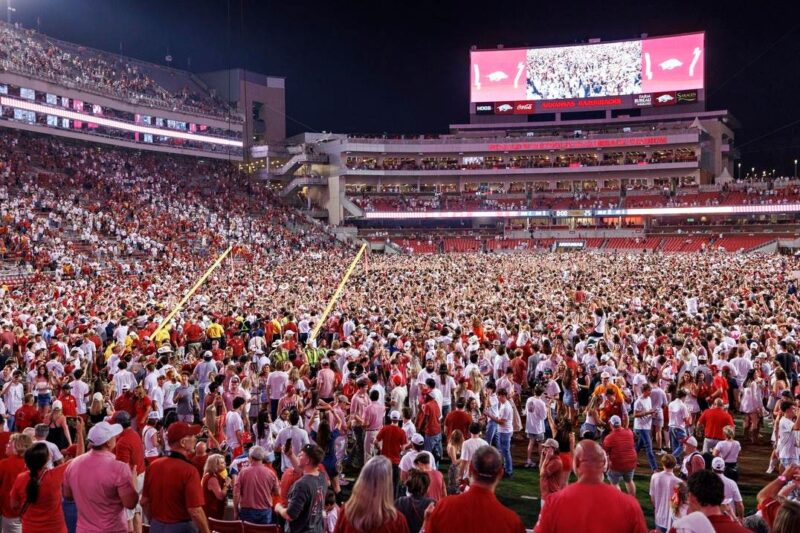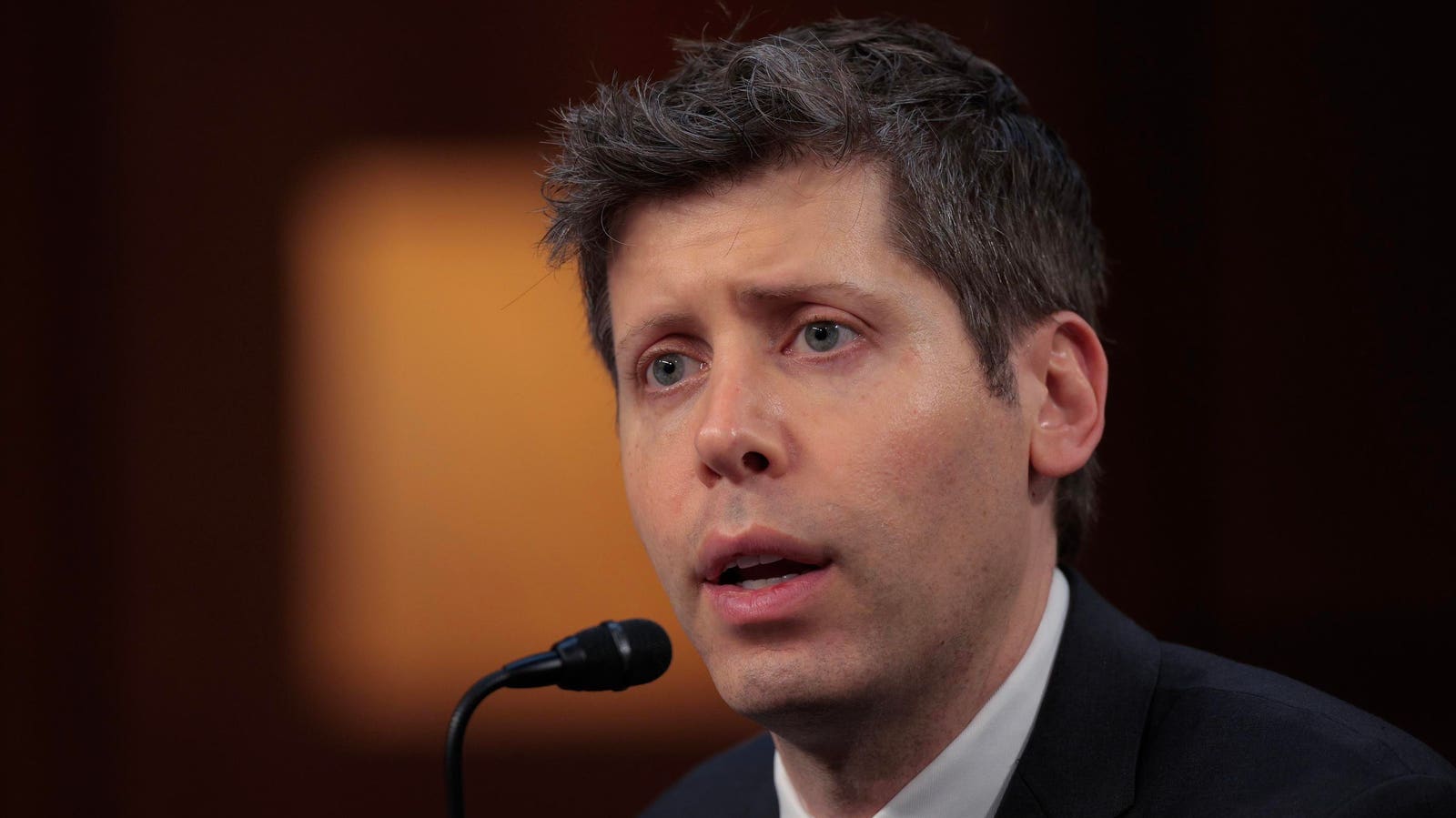CHARLOTTESVILLE, VA – SEPTEMBER 26: Virginia Cavaliers fans rush the field after the Cavaliers upset the Florida State Seminoles during a college football game between the Florida State Seminoles and the Virginia Cavaliers on September 26, 2025, at Scott Stadium in Charlottesville, VA. (Photo by Lee Coleman/Icon Sportswire via Getty Images)
Icon Sportswire via Getty Images
As a meteorologist and professor at the University of Georgia, I am fascinated by storms and love college football. In this space, I usually write about the science of storms and other weather-climate phenomena. Occasionally, I foray into odd intersections of my weather expertise and other topics. In recent weeks, I have thought carefully about students “storming” the field after college football games. Here’s my attempt to put some “scientific” perspective on the seemingly growing trend.
The Trends
It is pretty clear to me that there is an upward trend in field storming after NCAA football games, but there is no obvious database to analyze. Using proxy and anecdotal evidence, I find evidence to support my hypothesis. In 2021 FiveThirtyEight conducted an analysis. Only 8 weeks into the 2021 season, fans had stormed the field 15 times, which was more than all of the occurrences in 2018 (10) and 2019 (14). According to GatorSports.com, there were 30 field storming events during the 2020 COVID season. Keep reading for more insight on how the COVID years likely explain the explosion in field storming after 2020.
In 2016 Saturday Down South did an analysis of the last time every SEC team stormed the field. Alabama and Florida had no instances of field storming up to that point. Georgia had one in 2000 after a big win over Tennessee. Tennessee fans, itself, last stormed the field in 1998 though that has changed in recent years. Many of the other schools had not experienced “field storminess” in several years to over a decade.
NASHVILLE, TN – OCTOBER 05: Vanderbilt Commodores fans march the goal posts around the field following a game between the Vanderbilt Commodores and Alabama Crimson Tide, October 5, 2024 at FirstBank Stadium in Nashville, Tennessee. (Photo by Matthew Maxey/Icon Sportswire via Getty Images)
Icon Sportswire via Getty Images
This collection of data certainly suggests that before 2020, field storming was certainly a part of the college football culture but was more selectively used. In 2024 Ansley Graves opined in The Daily Beacon and asked whether storming the field has become too normalized. She framed her discussion in the history of students storming the field after big upsets, the realities of new financial penalties associated with doing so, and the indirect outcomes like the potential for injury or extra cleanup for staff.
The Psychology Behind It All
There are factors that seem to explain the extreme “downburst” of field storms in recent years. David Whitley sums up some of the social science reasoning behind the trends. In his 2022 piece, he wrote, “As to why this rushing plague has descended upon our land, psychologists cite two probable causes. Social media, and the quest to post a video or photo amid the mayhem. And the pandemic, which bottled up passions that need releasing.”
Let’s explore the COVID angle. Dr. Stephen P. Gonzalez is an expert in applied sport psychology and a sports administrator at Dartmouth. He told ESPN, “In a post-COVID year, I think that there’s just a lot of built-up or pent-up need for normalcy…. When athletics is a large part of a school’s identity and in some of these major conferences, it’s an opportunity for people to kind of feel like they’re a part of something that’s bigger than them.”
I certainly understand his “release valve” hypothesis. A study at the University of California – Santa Barbara documented the impact of COVID restrictions on teen social well-being. A university press release stated, “One year after the end of COVID-19 pandemic restrictions in California, adolescents reported an increase in feeling disconnected from their communities and negative thoughts about society in general.”
Storm Cloud over Huntington Beach, Orange County, California, USA. (Photo by: Citizen of the Planet/UCG/Universal Images Group via Getty Images)
UCG/Universal Images Group via Getty Images
The Meteorological Analogies To Field Storming
The other likely motivation is the rise of social media. If you watch recent field storming events, the students are certainly celebrating and enjoying themselves. There is something else that you will notice. Many of them are capturing every moment on their phones for various social media platforms. Social media has become the platform by which my kids’ generation documents their experiences, garner clout, and share moments in real-time. Heck, their videos can even land them on television or in a viral social media situation
In moments that students storm the field, it is like a “downburst” of people on to the field. In meteorology, a rapid burst of cool air in a thunderstorm is called a downburst. There is another similarity to meteorology and field storming. Tornadoes, hurricanes, and other extreme weather events are now captured on cellphones. Though very dangerous weather situations, the initial instinct for many people today is to record the event and then consider safety options later. Storm chasing excursions are also on the rise.
BLACKWELL, OK- MAY 29: Tempest Tours Senior Chase Guide Kinney Adams looks up into the sky to see which way the clouds are moving while stopped on the side of the road in the Great Plains in the United States of America May 29, 2006 outside of Blackwell, Oklahoma, USA. (Photos by Jeff Hutchens/Getty Images)
Getty Images
Many experts have grown concerned about safety aspects of field storming. When the University of Virginia upset my three-time alma mater Florida State University earlier this year, fans stormed the field. Nineteen people were directly or indirectly injured as a result of that particular “storm.” To protect fans and players, NCAA conferences have instituted various fine structures. Ansley Graves is keenly aware of that fact. She wrote, “Maybe just go out and celebrate with your friends, and not cost hundreds of thousands of dollars in fines and cleanup fees.”
SYRACUSE, NY – OCTOBER 13: Ervin Philips #3 of the Syracuse Orange celebrates the upset win over Clemson Tigers after fans storm the field at the Carrier Dome on October 13, 2017 in Syracuse, New York. Syracuse defeats Clemson 27-24. (Photo by Brett Carlsen/Getty Images)
Getty Images
Algorithms For Field Storming Appropriateness
Many fans and observers have proposed algorithms or guidance for when field storming is appropriate. David Whitley argued, “It should be over a top-3 team you haven’t beaten in at least 10 years.” Ansley Graves suggested, “Rushing the field should only be done in huge upset situations, not against a team who falls under the top 15 placement statistics with your own.”
FiveThirtyEight developed a metric called the What’re You Doing (On That Field), or WYD. They stated, “This isn’t meant to measure the quality of the storm itself, but rather the context leading up to it.” Their metric includes:
- Inputs for both team and opponent rank in Associated Press poll.
- Kickoff time.
- Whether matchup was a rivalry.
- Whether matchup went to overtime or not.
- Whether there was a walk-off scoring instance,
- Whether the game was decided by one score,
A higher WYD correlates with stronger justification for storming the field. They even did a WYD assessment for 2021 field storm events.
While I appreciate the science of these algorithms, I think Ansley Graves is probably the most accurate with her assessment. She concluded, “Storming the field is something that will continue to be controversial within college football, and in reality, there is not a whole lot that can be done. Besides, you aren’t going to tell hundreds of thousands of college students not to go on the field after a huge win.”
My hunch is that punitive approaches that impact the game, standings or playoff positioning would have more of an impact than fines, but that also seems excessive. Clemson fans have a tradition of storming the field for every home game. They found a way to make it work. As a professor and father of two current college students, let’s not be the “old fuddy-duddys.” Let’s find creative ways to allow the students to enjoy these moments but in a safe and responsible way.
Go Dawgs. Go Noles.
SOUTH BEND, IN – NOVEMBER 05: Notre Dame Fighting Irish fans are seen rushing the field in action after a game between the Notre Dame Fighting Irish and the Clemson Tigers on November 05, 2022 at Notre Dame Stadium in South Bend, IN. (Photo by Robin Alam/Icon Sportswire via Getty Images)
Icon Sportswire via Getty Images









